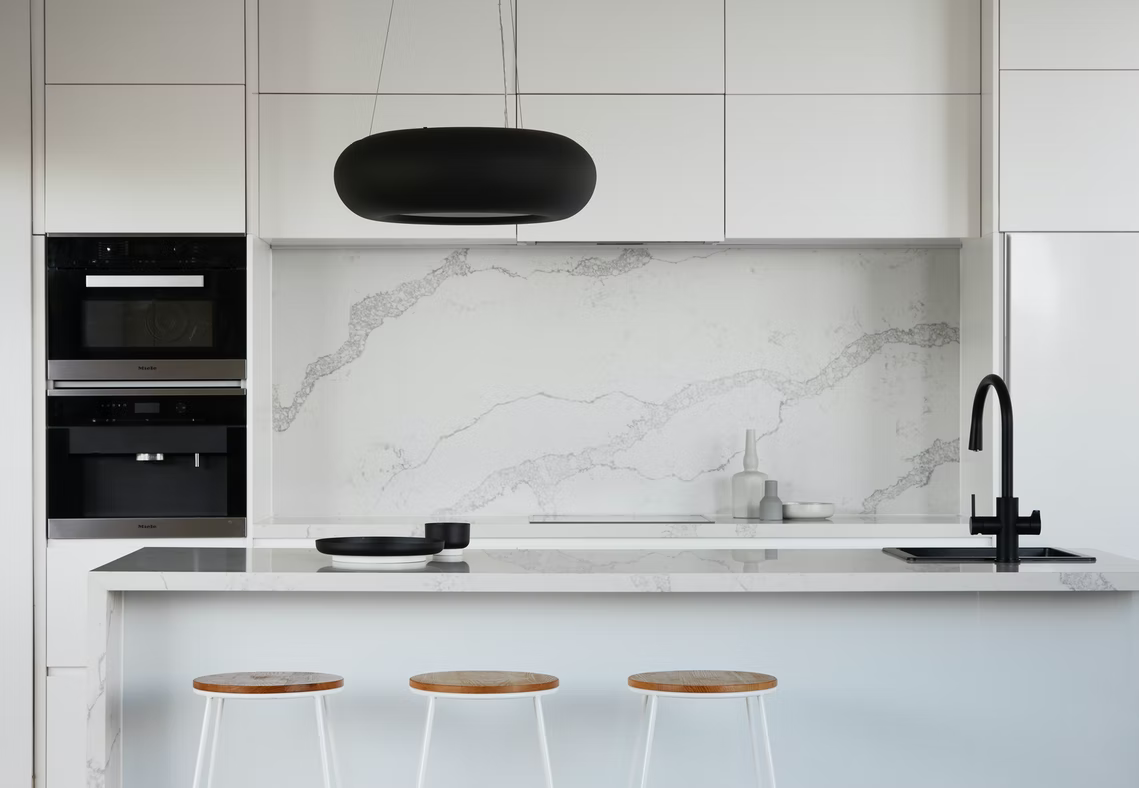Guide to Kitchen Backsplashes
Backsplashes are a common sight in kitchens, protecting walls from inevitable splattering from chopping areas and sinks. You can think of them as an extension to your counter, making your food prep areas more functional and eliminating the need to constantly repaint your walls.
What Are Backsplashes?
Backsplashes’ main purpose is to prevent water and flying food debris from damaging your walls. Kitchen designers usually place them behind the sink and along counters – basically anywhere prone to splattering.
Backsplashes are often tiled, but you can also get them in exotic stone, such as quartz, marble, Dekton, or granite, as well as other materials. They should strike a balance between aesthetics and functionality, complementing existing kitchen features.
Do You Actually Need A Backsplash?
Practically all modern kitchens come with backsplashes. Builders install them because they are easier to clean than plain painted walls and won’t degrade in the presence of moisture.
In most kitchens, the backsplash extends a couple of feet above work surfaces. However, in some, owners choose to build the backsplash all the way up to the ceiling, just in case. These applications are referred to as Full Height Backsplashes.
Different Types Of Backsplashes
There are a variety of different backsplash materials available on the market. These include:
Tiled: Tiled backsplashes are the most common and are highly effective at shielding walls from moisture. However, they can be difficult and time-consuming to install
Granite: Granite backsplashes are extremely durable, being made of one of the strongest rocks found in the Earth’s crust. Granite is a porous rock, meaning that it will allow moisture to enter. However, sealants make the stone’s exterior less penetrable
Quartz: Homeowners choose quartz backsplashes for their kitchens because they go with their quartz countertops and, unlike many other types of stone, don’t require sealing. As a bonus, it also cleans easily
Vinyl: Vinyl backsplashes are popular because they are cheap and easy to install. However, they can look tacky and are usually only suitable for low-end kitchens
Stainless steel: Stainless steel backsplashes are a rare sight in most residential kitchens. However, the material does sometimes make an appearance, thanks to its almost-unique tarnish-proof properties. Unlike most other metals, stainless steel doesn’t corrode in the presence of water, salt, or food debris. However, it will always retain an industrial aesthetic, regardless of how you dress it up.
Laminate or sheet glass: Some newer, trendier kitchens have sheet glass and laminate backsplashes. Installers paint the wall-facing side of the glass, letting it blend in with the kitchen’s color theme.
Exotic stone: Lastly, you might want to consider an exotic stone backsplash made of onyx or quartzite. Onyx is a precious stone often used in jewelry, while quartzite is a type of sandstone that looks particularly good when paired with a kitchen countertop made of the same stone
Is Stone The Best Backsplash Material?
Most people, if given the choice, would choose stone as their backsplash material. But what makes it such a good option?
Looks More Professional When Installed
While vinyl and tile backsplashes might keep water away from your walls, they can’t compete with stone in the style department. The in-person visual impact of quartz, granite, and Dekton is far greater than any other material on the market. Stone transforms your backsplash from a functional item into your kitchen’s undisputed centerpiece.
Extremely Versatile And Durable
Conventional backsplashes are often long-lasting, but, again, they don’t compare to stone. A high-quality granite or quartz backsplash could potentially last a hundred years, allowing you to use it again and again, no matter how many times you renovate your kitchen.
Suitable For All Kitchen Types
It doesn’t matter if you have a coastal, minimalist, tranquil, contemporary, Tuscan, or rustic kitchen, you can always find a stone backsplash to match.
Lets You Match Your Backsplash With Your Countertop
Pairing vinyl, tile or stainless steel backsplashes with a stone countertop can be a little jarring. It’ll do the job, but it doesn’t look great. Stone backsplashes, by contrast, always look great and help your kitchen make more sense.
Comes In A Variety Of Finishes
Lastly, stone backsplashes come in different types of finishes. These include:
Polished
Leathered
Quartz vs Granite Backsplashes
Generally, entry-level granite backsplashes tend to be more affordable than their quartz counterparts. Higher-end granite is more expensive, but rarer.
Quartz backsplashes offer the following benefits:
They look great in practically any kitchen
You can get a seamless finish because quartz slabs can be made to your kitchen’s precise measurements
They are easy to clean. Just wipe down with water and a mild detergent every day
They are nearly 100 percent non-porous. Unlike marble and granite, quartz doesn’t have many small holes where bacteria can thrive
By contrast, granite backsplashes have the following benefits:
They are extremely strong and durable
If you opt for entry-level products, they are relatively affordable
They are impeccably stylish, with an unmatched finish that no other material can emulate
Trust the Professionals
Installing a kitchen backsplash is no easy task. At Stoneworx®, we have decades of experience in dealing with stone products. Get in touch with our team to get started on your kitchen backsplash renovation project today.

